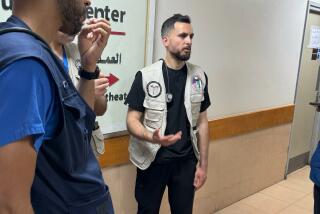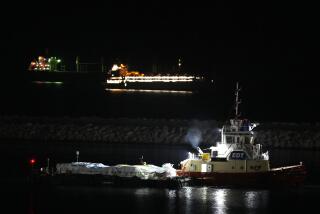To Fight Terror, Dispatch a Lifesaving Hospital Ship
- Share via
From the earliest moments of the war against terrorism, President Bush has balanced the projection of military force with a matching deployment of humanitarian assistance. In these days of unconventional, shadowy warfare, humanitarian aid can be a cost-effective means of winning the hearts and minds of those living under terrorism’s threat or tyranny’s boot.
In Afghanistan, the air campaign delivered food to a population close to starvation. Special Forces “A teams” not only hunted Al Qaeda and the Taliban, they set up aid stations to treat Afghans in need of medical care. But food drops and aid stations aren’t enough.
The 1987 cruise of the hospital ship Mercy to the South Pacific provides a model for a new humanitarian mission. In 1987, as commander in chief of the U.S. Pacific Fleet, I conceived the idea of providing the Mercy, which was just completing its conversion from a supertanker to a hospital ship, to tender medical assistance throughout Philippine provinces and other South Pacific island nations. The staff included Army, Navy, Air Force and public health doctors and nurses.
In nine weeks, the Mercy treated more than 63,000 people. We gave a blind man sight; a girl with a cleft palate a new life; the same for a boy with a club foot. In Zamboanga, a center of rebel activity, thousands of people defied the terrorists to receive medical treatment.
The Mercy’s mission created a huge amount of goodwill for the United States. My ultimate goal was to institutionalize such humanitarian deployments on an annual basis. But that never came to be realized after I retired.
Since 1987, the Mercy has been deployed only during Operation Desert Storm. But today, it could sail to a Muslim country, such as Pakistan, to become a floating teaching hospital, serving Pakistani citizens and Afghan refugees.
The Mercy’s presence would be highly visible, strategically influential and socially and politically effective. Just as the deployment of the ship to the Philippines helped buttress the fledgling democracy of Corazon Aquino’s presidency in 1987, so would a mission off Pakistan help President Pervez Musharraf combat the extremists who threaten his country’s fragile journey toward a democratic future.
One of the main objections raised against the Mercy’s deployment is that the U.S. government cannot afford to provide the medical staff. Dr. John Howe, Project Hope’s president, has offered the expertise of his organization, which could provide medical staff, as well as administrative and other support.
Given Project Hope’s long and effective experience in providing humanitarian assistance, a hospital ship program could be created quickly and efficiently. The staff would include volunteer doctors and nurses as well as other health professionals, Muslims among them. Industry donors would provide medical supplies. The Military Sealift Command would provide the ship and crew.
The underutilization of the Mercy (and its sister ship, the Comfort) represents the squandering of countless opportunities, not just to help nations desperate for state-of-the-art health care but also to win new friends for the United States.
The Navy’s argument against sending the Mercy to sea is that it might be needed if we go to war and must therefore remain dockside. As one who has ordered ships and their crews into harm’s way, I understand this concern. But I also know it is possible to shift the Mercy from humanitarian to military operation within the window required. Moreover, by placing it off the Pakistani coast instead of anchoring it at Oakland, the ship would be days closer to potential areas of operation in case of war.
My experience in the Philippines demonstrated how humanitarian missions can capture the hearts and souls of the “man in the street.” In these days of 24-hour cable and satellite news, the imposing sight of the Mercy deployed off Pakistan would be compelling visual proof of the president’s two-prong approach to defeat terrorism. We should grab this opportunity.
*
Adm. James A. Lyons Jr., USN (retired), was commander in chief of the U.S. Pacific Fleet from 1985 to 1987.
More to Read
Sign up for Essential California
The most important California stories and recommendations in your inbox every morning.
You may occasionally receive promotional content from the Los Angeles Times.













